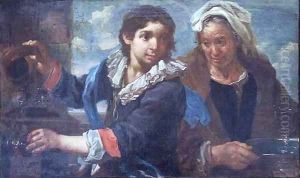Bernhardt Keyl Paintings
Bernhardt Keil, also known as Bernhard Keilhau or Monsù Bernardo, was a Danish Baroque painter whose artistic journey led him from Northern Europe to the flourishing art scene of Italy, where he left a significant mark with his works. Born in Helsingør, Denmark, in 1607, Keil's initial steps in the world of art were influenced by the Danish and Northern European painting tradition. However, his style and technique underwent a profound transformation following his move to Italy, a common destination for many artists of his time seeking inspiration and mastery in the arts.
Keil's arrival in Italy saw him joining the studio of Rembrandt's famed pupil, Pieter van Laer, in Rome. This period was crucial for Keil, as van Laer's influence steered his artistic direction towards the Bamboccianti style, characterized by scenes of everyday life in Rome, often focusing on the lower classes and imbued with a naturalistic detail that was innovative at the time. Keil became proficient in this genre, contributing significantly to its popularity and evolution.
Throughout the 1640s and 1650s, Keil's reputation grew, and he became known for his genre scenes, portraits, and religious paintings. His works are distinguished by their vivid realism, attention to detail, and the skillful use of light and shadow, which showed the influence of Caravaggio, another towering figure of Baroque art. Keil's paintings often depicted ordinary people and street scenes, bringing to life the everyday aspects of 17th-century Rome with empathy and a keen observational eye.
In addition to his genre paintings, Keil also received commissions for religious works, which were featured in Roman churches and cathedrals. These pieces showcased his versatility and ability to imbue traditional religious subjects with a sense of immediacy and emotional depth. Despite his success in Italy, Keil remained connected to his Danish roots, and his works played a role in introducing Italian Baroque elements into Danish and Northern European art.
Bernhardt Keil's contribution to the Baroque period extends beyond his paintings. He played a part in the broader cultural exchange between Italy and Northern Europe during the 17th century, helping to disseminate stylistic and thematic innovations across borders. He died in Rome in 1662, leaving behind a body of work that continues to be appreciated for its blend of realism, empathy, and technical mastery. Keil's legacy is evident in the collections of European art museums, where his paintings stand as testaments to the vibrant artistic exchange that defined the Baroque era.
